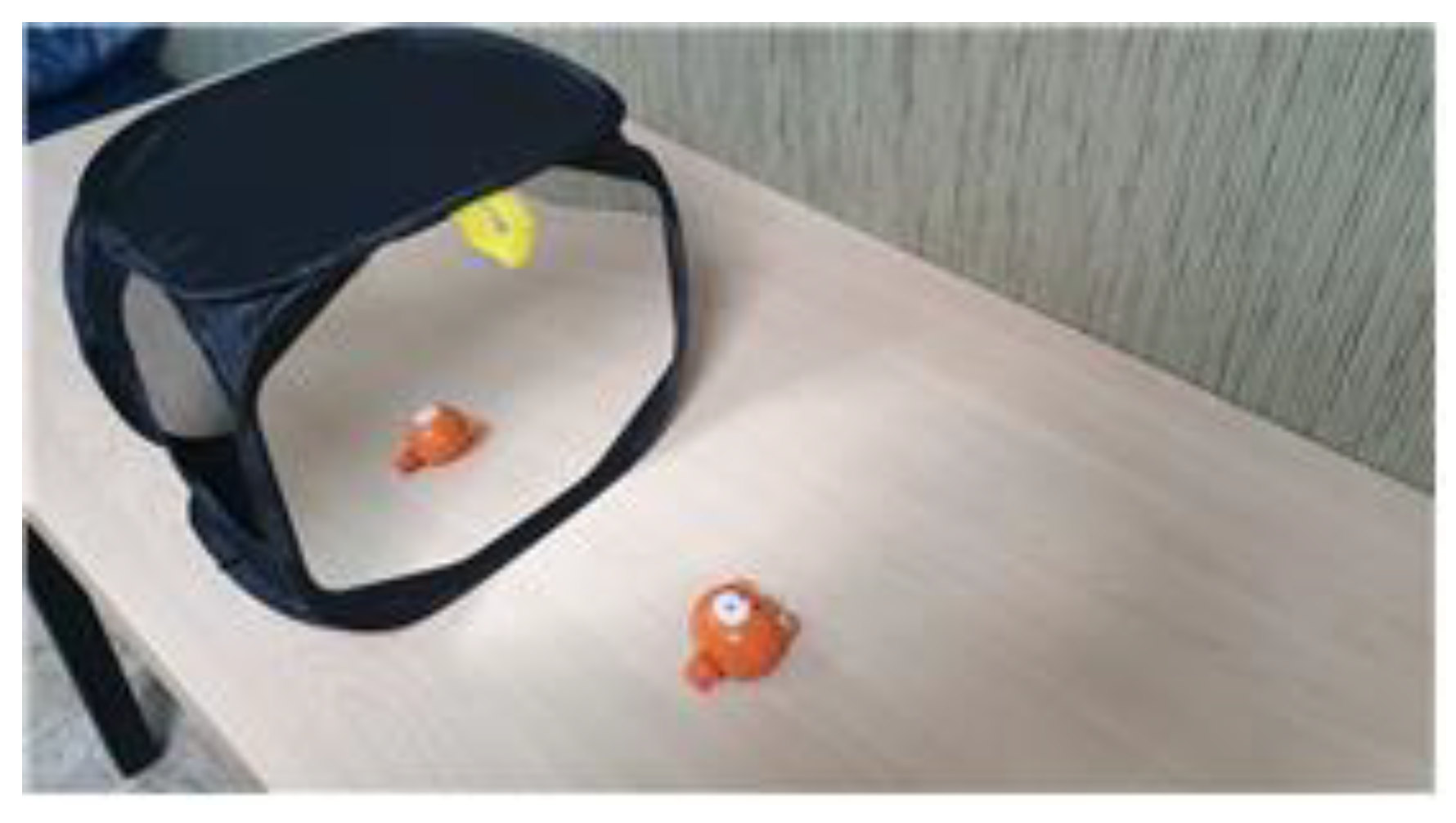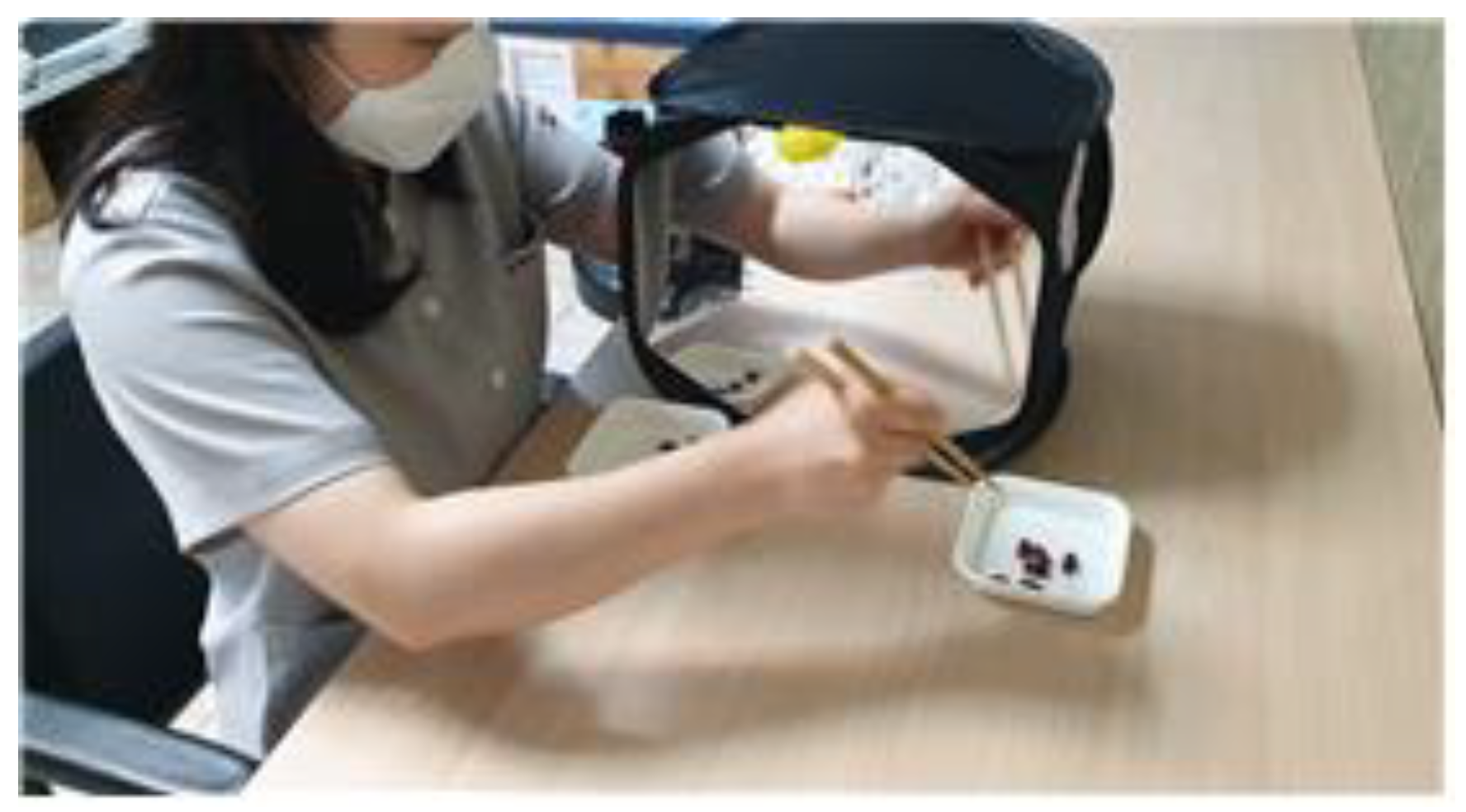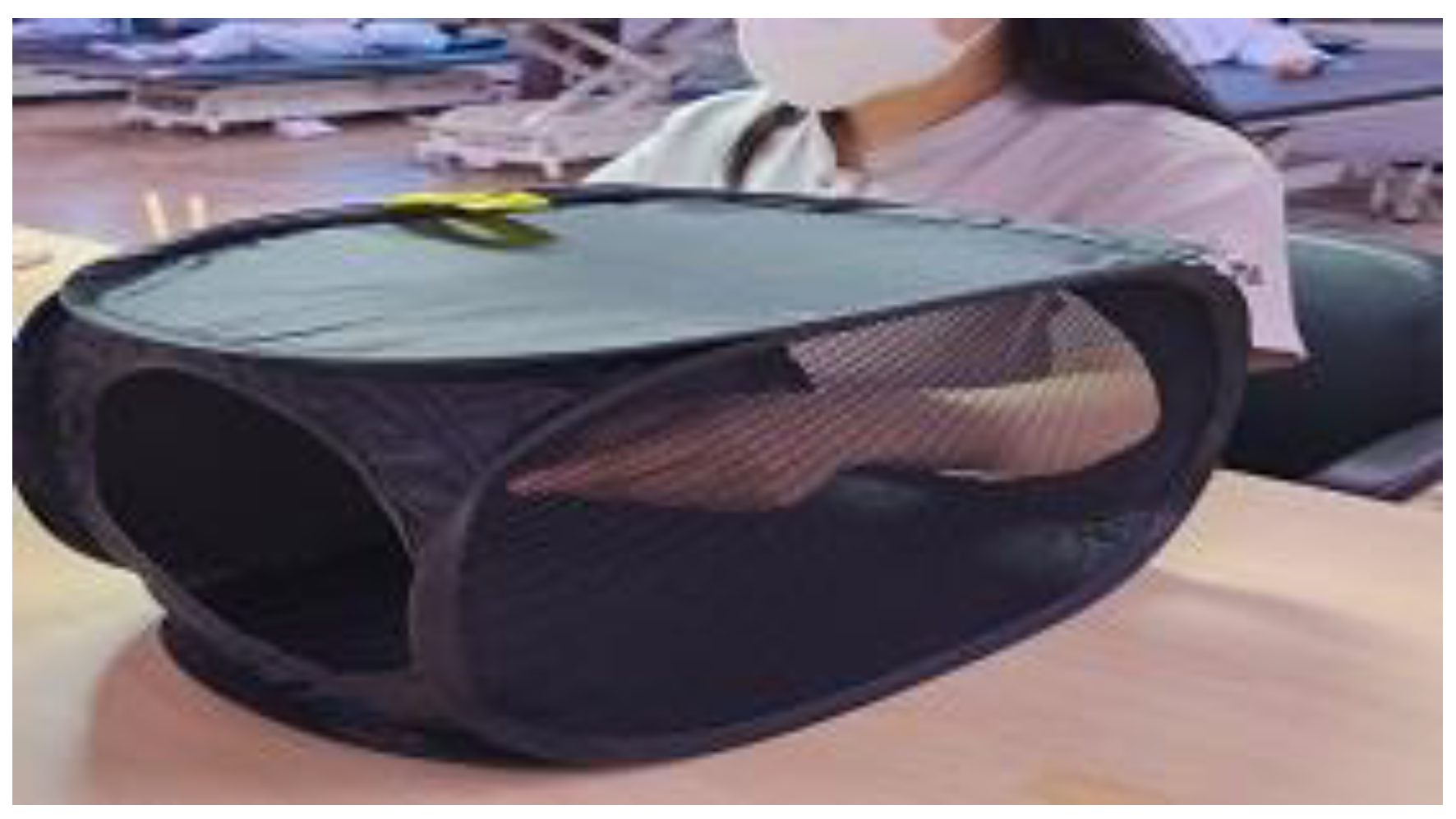Immediate Effects of Fine-Motor Training on Coordination and Dexterity of the Non-Dominant Hand in Healthy Adults: A Randomized Controlled Trial
Abstract
1. Introduction
2. Study Design and Methods
2.1. Study Design
2.2. Participants
2.3. Intervention Method
2.3.1. Experimental Group
2.3.2. Control Group
2.4. Research Tools
2.4.1. Coordination Assessment: Chopsticks Manipulation Test (CMT)
2.4.2. Dexterity Assessment: Purdue Pegboard Test (PPT)
2.5. Data Analysis
3. Results
3.1. General Characteristics of Participants
3.2. Changes in the Coordination of the Non-Dominant Hand
3.3. Changes in the Dexterity of the Non-Dominant Hand
3.4. Between-Group Comparison of Differences in Pre- and Post-Intervention Values of Coordination and Dexterity
4. Discussion
4.1. Brain Activation and Using Chopsticks
4.2. Effects of Fine-Motor Training Using a Mirror
4.3. Effects of Fine-Motor Training with Non-Dominant Hand
4.4. Implication
4.5. Limitations
5. Conclusions
Author Contributions
Funding
Institutional Review Board Statement
Informed Consent Statement
Data Availability Statement
Acknowledgments
Conflicts of Interest
References
- Boggio, P.S.; Castro, L.O.; Savagim, E.A.; Braite, R.; Cruz, V.C.; Rocha, R.R.; Rigonatti, S.P.; Silva, M.T.A.; Fregni, F. Enhancement of non-dominant hand motor function by anodal transcranial direct current stimulation. Neurosci. Lett. 2006, 404, 232–236. [Google Scholar] [CrossRef] [PubMed]
- Sperry, R.W. Left-brain, right-brain. Saturday Rev. 1975, 2, 30–32. [Google Scholar]
- Ramachandran, V.S.; Rogers-Ramachandran, D. Synaesthesia in Phantom Limbs Induced with Mirrors. Proc. Biol. Sci. 1996, 263, 377–386. [Google Scholar]
- Garry, M.; Loftus, A.; Summers, J. Mirror, mirror on the wall: Viewing a mirror reflection of unilateral hand movements facilitates ipsilateral M1 excitability. Exp. Brain Res. 2005, 163, 118–122. [Google Scholar] [CrossRef]
- Altschuler, E.L.; Wisdom, S.B.; Stone, L.; Foster, C.; Galasko, D.; E Llewellyn, D.M.; Ramachandran, V. Rehabilitation of hemiparesis after stroke with a mirror. Lancet 1999, 353, 2035–2036. [Google Scholar] [CrossRef]
- Louw, A.; Puentedura, E.J.; Reese, D.; Parker, P.; Miller, T.; Mintken, P.E. Immediate Effects of Mirror Therapy in Patients With Shoulder Pain and Decreased Range of Motion. Arch. Phys. Med. Rehabil. 2017, 98, 1941–1947. [Google Scholar] [CrossRef] [PubMed]
- Deconinck, F.J.; Smorenburg, A.R.; Benham, A.; Ledebt, A.; Feltham, M.G.; Savelsbergh, G.J. Reflections on mirror therapy: A systematic review of the effect of mirror visual feedback on the brain. Neurorehabilit. Neural Repair 2015, 29, 349–361. [Google Scholar] [CrossRef]
- Yavuzer, G.; Selles, R.; Sezer, N.; Sütbeyaz, S.; Bussmann, J.B.; Köseoğlu, F.; Atay, M.B.; Stam, H.J. Mirror therapy improves hand function in subacute stroke: A randomized controlled trial. Arch. Phys. Med. Rehabil. 2008, 89, 393–398. [Google Scholar] [CrossRef]
- Vogt, S.; Buccino, G.; Wohlschläger, A.M.; Canessa, N.; Shah, N.J.; Zilles, K.; Eickhoff, S.B.; Freund, H.-J.; Rizzolatti, G.; Fink, G.R. Prefrontal involvement in imitation learning of hand actions: Effects of practice and expertise. Neuroimage 2007, 37, 1371–1383. [Google Scholar] [CrossRef]
- Agnew, Z.K.; Wise, R.J.; Leech, R. Dissociating object directed and non-object directed action in the human mirror system; implications for theories of motor simulation. PLoS ONE 2012, 7, e32517. [Google Scholar] [CrossRef] [PubMed]
- Wang, J.; Fritzsch, C.; Bernarding, J.; Holtze, S.; Mauritz, K.H.; Brunetti, M.; Dohle, C. A comparison of neural mechanisms in mirror therapy and movement observation therapy. J. Rehabil. Med. 2013, 45, 410–413. [Google Scholar] [CrossRef]
- Shinoura, N.; Suzuki, Y.; Watanabe, Y.; Yamada, R.; Tabei, Y.; Saito, K.; Yagi, K. Mirror therapy activates outside of cerebellum and ipsilateral M1. NeuroRehabilitation 2008, 23, 245–252. [Google Scholar] [CrossRef] [PubMed]
- Jack, D.; Boian, R.; Merians, A.S.; Tremaine, M.; Burdea, G.C.; Adamovich, S.V.; Recce, M.; Poizner, H. Virtual reality-enhanced stroke rehabilitation. IEEE Trans. Neural Syst. Rehabil. Eng. 2001, 9, 308–318. [Google Scholar] [CrossRef] [PubMed]
- Invernizzi, M.; Negrini, S.; Carda, S.; Lanzotti, L.; Cisari, C.; Baricich, A. The value of adding mirror therapy for upper limb motor recovery of subacute stroke patients: A randomized controlled trial. Eur. J. Phys. Rehabil. Med. 2013, 49, 311–317. [Google Scholar]
- Michielsen, M.E.; Selles, R.W.; van der Geest, J.N.; Eckhardt, M.; Yavuzer, G.; Stam, H.J.; Smits, M.; Ribbers, G.M.; Bussmann, J.B.J. Motor recovery and cortical reorganization after mirror therapy in chronic stroke patients: A phase II randomized controlled trial. Neurorehabilit. Neural Repair 2011, 25, 223–233. [Google Scholar] [CrossRef]
- Johnston, J.A.; Bobich, L.R.; Santello, M. Coordination of intrinsic and extrinsic hand muscle activity as a function of wrist joint angle during two-digit grasping. Neurosci. Lett. 2010, 474, 104–108. [Google Scholar] [CrossRef]
- Sawamura, D.; Sakuraba, S.; Suzuki, Y.; Asano, M.; Yoshida, S.; Honke, T.; Kimura, M.; Iwase, Y.; Horimoto, Y.; Yoshida, K.; et al. Acquisition of chopstick-operation skills with the non-dominant hand and concomitant changes in brain activity. Sci. Rep. 2019, 9, 20397. [Google Scholar] [CrossRef]
- Wu, S.-P. Effects of the handle diameter and tip angle of chopsticks on the food-serving performance of male subjects. Appl. Ergon. 1995, 26, 379–385. [Google Scholar] [CrossRef]
- Chen, H.-M.; Chang, J.-J. The skill components of a therapeutic chopsticks task and their relationship with hand function tests. Kaohsiung J. Med. Sci. 1999, 15, 704–709. [Google Scholar]
- Lee, R.-N.; Chae, S.-Y.; Song, B.-K. Combined Study on between Hand Dexterity and Grip Strength in Students of Colleges and Elementary School. J. Korea Converg. Soc. 2019, 10, 55–61. [Google Scholar]
- Chia, F.-Y.; Saakes, D. Interactive training chopsticks to improve fine motor skills. In Proceedings of the 11th Conference on Advances in Computer Entertainment Technology, Funchal, Madeira, Portugal, 11–14 November 2014; pp. 1–4. [Google Scholar]
- Bang, Y.; Kim, H. Effect of Real Environment and Structured Environment on Acquisition of Chopstick Skill with Non-Dominant Hand. J. Korean Growth Dev. 2008, 16, 181–185. [Google Scholar]
- Faul, F.; Erdfelder, E.; Lang, A.-G.; Buchner, A. G*Power 3: A flexible statistical power analysis program for the social, behavioral, and biomedical sciences. Behav. Res. Methods 2007, 39, 175–191. [Google Scholar] [CrossRef]
- Chang, J.; Chien, T.; Lin, Y. Comparison of various patterns of chopstick use and functional performance. Kaohsiung J. Med. Sci. 1993, 9, 428–434. [Google Scholar]
- Tiffin, J.; Asher, E.J. The Purdue Pegboard: Norms and studies of reliability and validity. J. Appl. Psychol. 1948, 32, 234. [Google Scholar] [CrossRef] [PubMed]
- Järveläinen, J.; Schürmann, M.; Hari, R. Activation of the human primary motor cortex during observation of tool use. Neuroimage 2004, 23, 187–192. [Google Scholar] [CrossRef]
- Morishita, T.; Uehara, K.; Funase, K. Changes in interhemispheric inhibition from active to resting primary motor cortex during a fine-motor manipulation task. J. Neurophysiol. 2012, 107, 3086–3094. [Google Scholar] [CrossRef] [PubMed]
- Matsuo, M.; Iso, N.; Fujiwara, K.; Moriuchi, T.; Tanaka, G.; Honda, S.; Matsuda, D.; Higashi, T. Cerebral haemodynamics during motor imagery of self-feeding with chopsticks: Differences between dominant and non-dominant hand. Somatosens. Mot. Res. 2020, 37, 6–13. [Google Scholar] [CrossRef]
- Kirby, K.M.; Pillai, S.R.; Carmichael, O.T.; Van Gemmert, A.W. Brain functional differences in visuo-motor task adaptation between dominant and non-dominant hand training. Exp. Brain Res. 2019, 237, 3109–3121. [Google Scholar] [CrossRef]
- Matthys, K.; Smits, M.; Van der Geest, J.N.; Seurinck, R.; Stam, H.J.; Selles, R.W. Mirror-induced visual illusion of hand movements: A functional magnetic resonance imaging study. Arch. Phys. Med. Rehabil. 2009, 90, 675–681. [Google Scholar] [CrossRef] [PubMed]
- Munn, J.; Herbert, R.D.; Gandevia, S.C. Contralateral effects of unilateral resistance training: A meta-analysis. J. Appl. Physiol. 2004, 96, 1861–1866. [Google Scholar] [CrossRef]
- Carson, R. Neural pathways mediating bilateral interactions between the upper limbs. Brain Res. Rev. 2005, 49, 641–662. [Google Scholar] [CrossRef] [PubMed]
- Carroll, T.J.; Herbert, R.D.; Munn, J.; Lee, M.; Gandevia, S.C. Contralateral effects of unilateral strength training: Evidence and possible mechanisms. J. Appl. Physiol. 2006, 101, 1514–1522. [Google Scholar] [CrossRef] [PubMed]
- Rizzolatti, G.; Fogassi, L.; Gallese, V. Neurophysiological mechanisms underlying the understanding and imitation of action. Nat. Rev. Neurosci. 2001, 2, 661–670. [Google Scholar] [CrossRef] [PubMed]





| Characteristic | EG (n = 50) | CG (n = 50) | p |
|---|---|---|---|
| Gender (male/female) | 28/22 | 27/23 | 0.843 |
| Age (years) | 29.94 ± 4.02 | 30.32 ± 4.01 | 0.637 |
| Height (cm) | 169.92 ± 9.70 | 169.00 ± 7.74 | 0.601 |
| Weight (kg) | 67.28 ± 12.88 | 66.98 ± 14.35 | 0.913 |
| Dominance hand (L./R.) | 1/49 | 3/47 | 0.312 |
| EG (n = 50) | CG (n = 50) | t | p | |
|---|---|---|---|---|
| Pre | 59.62 ± 15.02 | 61.91 ± 15.14 | 0.759 | 0.450 |
| Post | 51.67 ± 9.73 | 50.30 ± 14.50 | 0.555 | 0.580 |
| t | 3.541 | 5.346 | ||
| p | 0.001 * | <0.001 * |
| EG (n = 50) | CG (n = 50) | t | p | |
|---|---|---|---|---|
| Pre | 58.13 ± 10.86 | 58.30 ± 7.80 | 0.088 | 0.930 |
| Post | 52.80 ± 6.31 | 54.58 ± 6.23 | 1.420 | 0.159 |
| t | 5.616 | 4.500 | ||
| p | <0.001 * | <0.001 * |
| EG (n = 50) | CG (n = 50) | t | p | |
|---|---|---|---|---|
| CMT | −7.95 ± 15.88 | −11.61 ± 15.36 | −1.172 | 0.244 |
| PPT | −5.34 ± 6.72 | −3.72 ± 5.85 | 1.282 | 0.203 |
Publisher’s Note: MDPI stays neutral with regard to jurisdictional claims in published maps and institutional affiliations. |
© 2022 by the authors. Licensee MDPI, Basel, Switzerland. This article is an open access article distributed under the terms and conditions of the Creative Commons Attribution (CC BY) license (https://creativecommons.org/licenses/by/4.0/).
Share and Cite
Park, C.; Son, H. Immediate Effects of Fine-Motor Training on Coordination and Dexterity of the Non-Dominant Hand in Healthy Adults: A Randomized Controlled Trial. Behav. Sci. 2022, 12, 446. https://doi.org/10.3390/bs12110446
Park C, Son H. Immediate Effects of Fine-Motor Training on Coordination and Dexterity of the Non-Dominant Hand in Healthy Adults: A Randomized Controlled Trial. Behavioral Sciences. 2022; 12(11):446. https://doi.org/10.3390/bs12110446
Chicago/Turabian StylePark, Chanhyun, and Hohee Son. 2022. "Immediate Effects of Fine-Motor Training on Coordination and Dexterity of the Non-Dominant Hand in Healthy Adults: A Randomized Controlled Trial" Behavioral Sciences 12, no. 11: 446. https://doi.org/10.3390/bs12110446
APA StylePark, C., & Son, H. (2022). Immediate Effects of Fine-Motor Training on Coordination and Dexterity of the Non-Dominant Hand in Healthy Adults: A Randomized Controlled Trial. Behavioral Sciences, 12(11), 446. https://doi.org/10.3390/bs12110446








